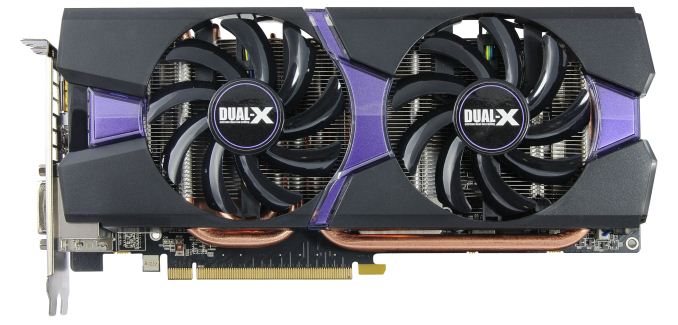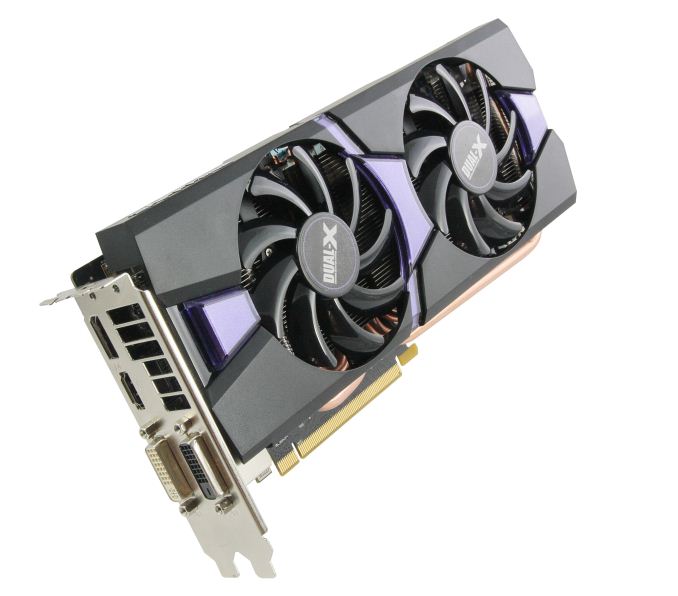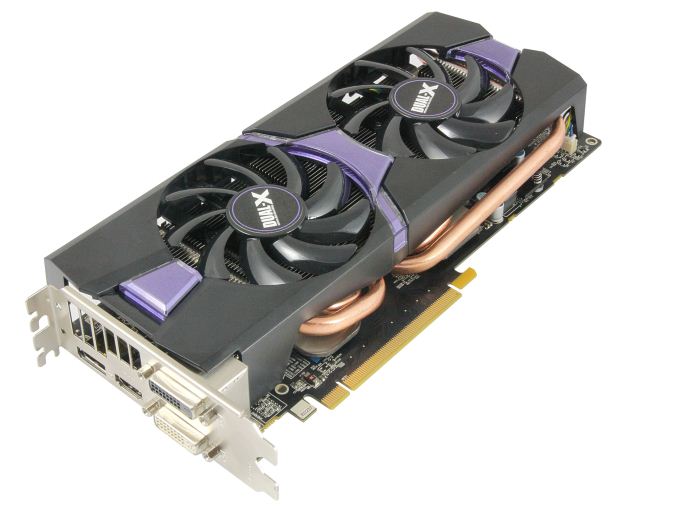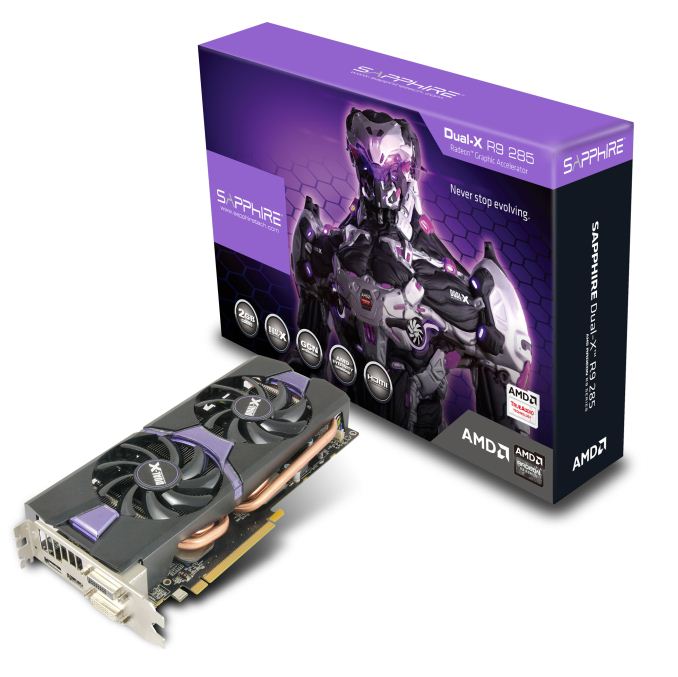AMD Radeon R9 285 Review: Feat. Sapphire R9 285 Dual-X OC
by Ryan Smith on September 10, 2014 2:00 PM ESTMeet The Sapphire R9 285 Dual-X OC 2GB
Our sample provided by AMD for today’s launch is Sapphire’s R9 285 Dual-X OC 2GB. As we mentioned before this is a non-reference launch, so rather than ship out engineering cards that won’t see retail AMD has sent us proper retail cards.
Sapphire’s R9 285 Dual-X OC is in turn a good example of what kinds of cards are appearing on store shelves. As R9 285 is a sub-200W product all of the launch cards have followed the same basic design, utilizing their manufacturer’s respective dual fan open air designs. So if you like full size open air cards then you’ll have your pick of the litter. However it also means that there aren’t any blowers on the market – nor do we expect any in the development pipeline – so for the moment the market for R9 285s is rather homogenous. In Sapphire’s case, though not available at launch, we will eventually see them break the mold with a smaller single-fan card specifically designed for use in ITX systems.
But getting to the R9 285 Dual-X OC, the Dual-X is a solid entry from Sapphire that is very typical of their current designs. As given away by the name, this card utilizes a 10” version of Sapphire’s Dual-X open-air cooler, and among Sapphire’s product lineup it can be considered the company’s baseline cooler for products up to 250W. Meanwhile as an OC model Sapphire is shipping this card with a mild factory overclock of 965MHz for the core and 5.6GHz for the memory, which represents a 47MHz (5%) core overclock and 100MHz (2%) memory overclock. Though note that Sapphire is also producing an identical version of this hardware without the factory overclock.
Continuing with our overall theme of R9 285 being a lateral product for AMD, the same is unsurprisingly true for Sapphire. For the R9 285 Dual-X Sapphire has opted to port over the design of their existing R9 280 Dual-X (which happens to be our R9 280 test card), building a suitable new PCB for Tonga but otherwise retaining the R9 280’s cooler and functionality. With R9 280 being a more power hungry part (on paper at least), this means the R9 285 Dual-X cooler is slightly overpowered in comparison, which should bode well for temperature/acoustic performance and for overclocking.
The Dual-X cooler itself is something of a tried and true design for Sapphire at this point, as years of iteration on dual fan coolers has resulted in these designs coalescing into similar and highly effective coolers. Starting from the top, the 10” version of the Dual-X cooler utilizes a pair of 85mm fans, allowing it to provide more than sufficient airflow for the primary and VRM heatsinks. Buyers with cramped cases will want to note that the use of such a large fan does result in a shroud larger than the PCB itself, with the shroud extending an additional 1cm over the PCB.
Below the fans we find Sapphire’s primary heatsink, which is composed of aluminum and runs just short of the entire length of the cooler. Sapphire attaches the primary heatsink to the GPU through the use of 4 copper heatpipes which run between the GPU and various points on the heatsink. The heatpipes in turn do not make direct contact with the GPU, but instead attach to a copper baseplate which in turn is what makes contact with the GPU and channels heat into the heatpipes.
Surrounding the copper baseplate is a secondary aluminum baseplate which provides both structure for the overall heatsink and additional cooling. Through the use of thermal pads, the aluminum baseplate covers the card’s RAM chips, providing direct cooling for the RAM. Meanwhile the card’s VRMs are not part of the primary heatsink assembly, and are instead cooled via a smaller secondary “strip” heatsink that sits over the MOSFETs towards the rear of the card. Airflow making it through the primary heatsink is in turn responsible for cooling this secondary heatsink.
Removing the heatsink and accessing the PCB, Sapphire’s PCB is typical for a 200W card. Sapphire places the bulk of the VRM circuitry towards the rear of the card, between the GPU/RAM and the PCIe power sockets. Meanwhile Sapphire’s RAM of choice is 6GHz Elpedia, which means this card ships at a lower memory frequency than what the RAM is capable of. For overclockers this means there’s some guaranteed headroom on the RAM, while the lower shipping frequency may indicate that AMD has tuned Tonga’s memory controllers for sub-6GHz operation, similar to what happened with Hawaii.
Throughout all of this the R9 285 Dual-X OC is generally a solid card, but the heatsink/PCB interaction does expose the card’s one real weakness/design flaw, which is a lack of rigidity. As is almost always the case with these large heatsink cards, the heatsink is massive enough that for all practical purposes the PCB is attached to the heatsink rather than vice versa. However Sapphire only attaches the heatsink to the PCB at the 4 screws around the GPU, which for a 10.25” card means the far end of the card is far removed from these attachment points and is left free to flex. Sapphire does include a plastic leg at one corner of the shroud to keep the PCB from flexing too much, but this leg isn’t secured to the PCB and indeed isn’t even long enough to touch the PCB without flexing. Ideally we would like to see all 9”+ cards reinforced against flexing for this reason, either by securing the shroud to the PCB at the rear of the card or by employing a stiffener along the top edge of the PCB.
Moving on, Sapphire doesn’t list an official TDP for the R9 285 Dual-X OC, however given the factory overclock it’s fair to say that in practice it’s going to be a bit higher than AMD’s official 190W TDP of a stock R9 285. Providing power for the card is a pair of 6pin PCIe power connectors at the top-rear of the card, which along with the PCIe slot connector means the card has the means to deliver up to 225W of power (VRMs willing). Interestingly Sapphire’s PCB has an additional pair of solder points for replacing one of the 6pin connectors with an 8pin connector, which may indicate a future Sapphire card or Sapphire hedging their bets for the inevitable higher tier Tonga card with all 32 CUs enabled.
Meanwhile though you won’t find a Crossfire connector at the top of the card – having been made obsolete by GCN 1.1+’s XDMA engines – what you will find on the Sapphire card is a BIOS switch. Sapphire ships the R9 285 Dual-X as a dual BIOS UEFI card, with one BIOS for legacy systems and a second BIOS for UEFI systems. The card’s default shipping state will be for the legacy BIOS, while depressing the BIOS button will switch to UEFI. Outside of reference cards we don’t see too many dual BIOS cards, and given the limited selection of such cards we are rather fond of the fact that Sapphire uses a button here as opposed to a more difficult to access switch.
Finally, towards the front of the card we see the standard AMD 200 series I/O configuration of 1x DL-DVI-I, 1x DL-DVI-D, 1x HDMI, and 1x DisplayPort. Tonga has up to 6 display controllers, and while not easy it should be possible to use all 6 of them through a careful use of MST off of the DisplayPort and identical monitors hanging off of the HDMI and DVI ports.
Wrapping things up, the retail price on the R9 285 Dual-X OC is currently running at $259. This puts Sapphire’s card at $10 over the R9 285 MSRP of $249, though given the fact that this is a factory overclocked card this is par for the course. We haven’t seen the non-OC version for sale yet, but one way or another you’re essentially looking at paying a 4% price premium for roughly as much of a performance advantage over a stock R9 285.














86 Comments
View All Comments
CrazyElf - Wednesday, September 10, 2014 - link
All in all, this doesn't really change the market all that much.I still very firmly feel that the R9 290 right now (Q3 2014) remains the best price:performance of the mid to high end cards. That and the 4GB VRAM which may make it more future proof.
What really is interesting at this point is what AMD has to respond on Nvidia's Maxwell.
MrSpadge - Wednesday, September 10, 2014 - link
I Agree - Tonga is not bad, but on the other hand it does not change anything substantially compared to Tahiti. This would have been a nice result 1 - 1.5 years after the introduction of Tahiti. But that's almost been 3 years ago! The last time a GPU company showed no real progress after 3 years they went out of business shortly afterwards...And seing how AMD brags to beat GTX760 almost makes cry. That's the double cut-down version of a 2.5 years old chip which is significantly smaller than Tonga! This is only a comparison because nVidia kept this card at a far too high price because there was no competitive pressure from AMD.
If this is all they have their next generation will get stomped by Maxwell.
iLovefloss - Wednesday, September 10, 2014 - link
So all you got from this review is that Tonga is a cut down version of Tahiti? After reading this review, this is the impression you were left with?MrSpadge - Thursday, September 11, 2014 - link
Nope. But in the end the result performs just the same at even almost the same power consumption. Sure, there are some new features.. but so far and I expect for the foreseeable future they don't matter.Demiurge - Wednesday, September 10, 2014 - link
This is the first mid-range card to have all the value add features of the high-end cards. I wish AMD would leverage TrueAudio better, but the other features and the nice TDP drop.The color compression enhancement is a very interesting feature. I think that in itself deserves a little applause because of its significance in the design and comparing to the 280's. I think this is more significant, not as a performance feature, but similar to what Maxwell represented for NV in terms of efficiency. Both are respectable design improvements, in different areas. It's a shame they don't cross-license... seems like such as waste.
MrSpadge - Thursday, September 11, 2014 - link
Well, the TDP-drop is real, but mostly saves virtual power. By this I mean that 280 / 7950 never come close to using 250 W, and hence the savings from Tonga are far less than the TDP difference makes it seem. The average between different articles seems to be ~20 W saving at the wall and establishes about a power-efficiency parity with cards like GTX670.The color compression could be Tongas best feature. But I still wonder: if Pitcairn on 270X comes so close to 285 and 280 performance with 256 bit memory bus and without color compression.. how much does it really matter (for 285)? To me it seems that Tahiti most often didn't need that large bus rather than color compression working wonders for Tonga. Besides, GTX770 and GTX680 also hold up fine at that performance level with a 256 bit bus.
Demiurge - Thursday, September 11, 2014 - link
The TDP drop is something I did not think about being a paper launch value. You make a good point about the color compression too. It will be interesting how both fair. That may be an interesting topic to follow up during the driver refresh.As an owner of GTX 260 with a 448-bit bus, I can tell you that with anti-aliasing, it matters quite a bit as that becomes the limiter. The shader count is definitely not the limiter usually in the low-end and mid-range displays that these cards will typically be paired with. My GTX 260 and 1280x1024 monitor kind of illustrate that with 216 Shaders/896MB. :-)
It isn't pretty, but I don't see anything that forces me to upgrade yet. Think I've got two more generations or so to wait on before performance is significant enough, or a groundbreaking feature would do it. I'm actually considering upgrading out of boredom and interest in gimmicky features more than anything else at this point.
TiGr1982 - Thursday, September 11, 2014 - link
GTX 260 is like 6 years old now. It's lacking DX11, having less than 1 GB of (relatively slow) GDDR3 VRAM, and overall should be 3-4 times slower than R9 285 or R9 290, I guess.I really didn't think anybody still uses these old gen cards (e.g. I have HD 7950 Boost Dual-X which is essentially identical to R9 280).
P39Airacobra - Friday, January 9, 2015 - link
Because they would loose money! LOL. And they are both about the same anyway, Except AMD goes for brute force to get performance,(like using aV8) And Nvidia uses efficency with power. (Like a turbo charged 4cyl or 6cyl)bwat47 - Thursday, September 11, 2014 - link
"And seing how AMD brags to beat GTX760 almost makes cry. That's the double cut-down version of a 2.5 years old chip which is significantly smaller than Tonga! This is only a comparison because nVidia kept this card at a far too high price because there was no competitive pressure from AMD."You are being pretty silly here. Both AMD and Nvidia were rebranding a lot of cards these last few gens. You can'y go after AMD for rebranding a 2-3 year old chip, and then say its fine if nvidia does it and blame AMD's 'lack of competitive pressure'. If lack of competitive pressure was the reason for rebranding, then there was lack of competitive pressure on both sides.
And I highly doubt the 285 is 'all amd has'. this was just a small update to their product line, to bring some missing features (freesync, true audio etc...), and reduced power consumption to the 28x series. I'm sure there is a 3xx series coming down the road (or whatever they will call it). Both AMD and nvidia have been working been squeezing all they can out of older architecture for the past few years, you can't really put the blame on one of the other without being hypocritical.